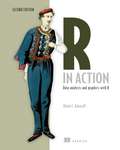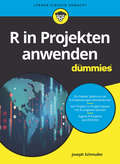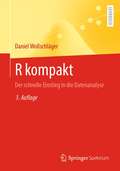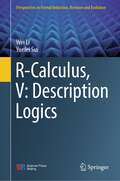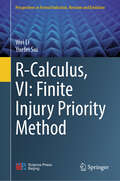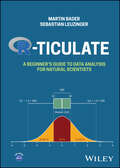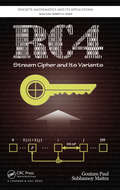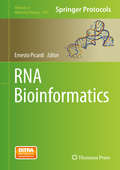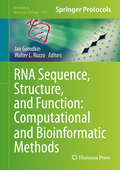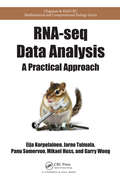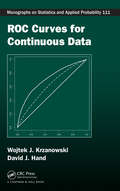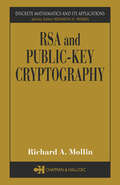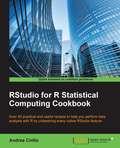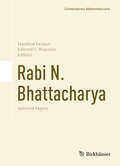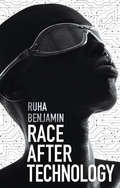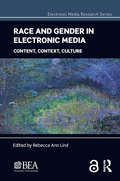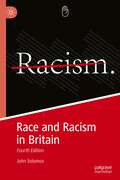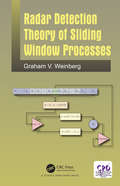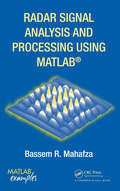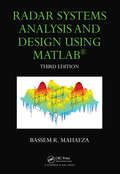- Table View
- List View
R in Action: Data analysis and graphics with R
by Robert I. KabacoffSummaryR in Action, Second Edition presents both the R language and the examples that make it so useful for business developers. Focusing on practical solutions, the book offers a crash course in statistics and covers elegant methods for dealing with messy and incomplete data that are difficult to analyze using traditional methods. You'll also master R's extensive graphical capabilities for exploring and presenting data visually. And this expanded second edition includes new chapters on time series analysis, cluster analysis, and classification methodologies, including decision trees, random forests, and support vector machines.Purchase of the print book includes a free eBook in PDF, Kindle, and ePub formats from Manning Publications.About the TechnologyBusiness pros and researchers thrive on data, and R speaks the language of data analysis. R is a powerful programming language for statistical computing. Unlike general-purpose tools, R provides thousands of modules for solving just about any data-crunching or presentation challenge you're likely to face. R runs on all important platforms and is used by thousands of major corporations and institutions worldwide.About the BookR in Action, Second Edition teaches you how to use the R language by presenting examples relevant to scientific, technical, and business developers. Focusing on practical solutions, the book offers a crash course in statistics, including elegant methods for dealing with messy and incomplete data. You'll also master R's extensive graphical capabilities for exploring and presenting data visually. And this expanded second edition includes new chapters on forecasting, data mining, and dynamic report writing.What's InsideComplete R language tutorialUsing R to manage, analyze, and visualize dataTechniques for debugging programs and creating packagesOOP in ROver 160 graphsAbout the AuthorDr. Rob Kabacoff is a seasoned researcher and teacher who specializes in data analysis. He also maintains the popular Quick-R website at statmethods.net.Table of ContentsPART 1 GETTING STARTEDIntroduction to RCreating a datasetGetting started with graphsBasic data managementAdvanced data managementPART 2 BASIC METHODSBasic graphsBasic statisticsPART 3 INTERMEDIATE METHODSRegressionAnalysis of variancePower analysisIntermediate graphsResampling statistics and bootstrappingPART 4 ADVANCED METHODSGeneralized linear modelsPrincipal components and factor analysisTime seriesCluster analysisClassificationAdvanced methods for missing dataPART 5 EXPANDING YOUR SKILLSAdvanced graphics with ggplot2Advanced programmingCreating a packageCreating dynamic reportsAdvanced graphics with the lattice package available online only from manning.com/kabacoff2
R in Projekten anwenden für Dummies (Für Dummies)
by Joseph SchmullerDieses Buch bietet einen einzigartigen Learning-by-Doing-Ansatz. Sie werden Ihre R-Fähigkeiten erweitern und vertiefen, indem Sie eine Vielzahl von Beispielprojekten aus der Praxis nachvollziehen. Erlernen Sie die Grundlagen von R und RStudio sowie Möglichkeiten der Datenreduktion, des Mapping und der Bildverarbeitung. Dabei kommen Werkzeuge zum Einsatz, die Daten grafisch auswerten, die Analyse interaktiv machen oder die maschinelles Lernen einsetzen. Und auf dem Weg dahin können Sie sogar Ihr Statistikwissen noch erweitern. Warum sollten Sie das Rad neu erfinden, wenn es schon fertige R-Pakete gibt, die Ihre Bedürfnisse bedienen? Hier lernen Sie sie kennen.
R in a Nutshell: A Desktop Quick Reference
by Joseph AdlerIf you’re considering R for statistical computing and data visualization, this book provides a quick and practical guide to just about everything you can do with the open source R language and software environment. You’ll learn how to write R functions and use R packages to help you prepare, visualize, and analyze data. Author Joseph Adler illustrates each process with a wealth of examples from medicine, business, and sports.Updated for R 2.14 and 2.15, this second edition includes new and expanded chapters on R performance, the ggplot2 data visualization package, and parallel R computing with Hadoop.Get started quickly with an R tutorial and hundreds of examplesExplore R syntax, objects, and other language detailsFind thousands of user-contributed R packages online, including BioconductorLearn how to use R to prepare data for analysisVisualize your data with R’s graphics, lattice, and ggplot2 packagesUse R to calculate statistical fests, fit models, and compute probability distributionsSpeed up intensive computations by writing parallel R programs for HadoopGet a complete desktop reference to R
R kompakt: Der schnelle Einstieg in die Datenanalyse
by Daniel WollschlägerDieses Buch bietet eine kompakte Einführung in die Datenauswertung mit der freien Statistikumgebung R. Ziel ist es dabei, einen Überblick über die Funktionalität von R zu liefern und einen schnellen Einstieg in die deskriptive Datenauswertung sowie in die Umsetzung der wichtigsten statistischen Tests zu ermöglichen. Zudem deckt das Buch die vielfältigen Möglichkeiten ab, Diagramme zu erstellen, Daten mit anderen Programmen auszutauschen und R durch Zusatzpakete zu erweitern. Das Buch ist damit für Leser geeignet, die R kennenlernen und rasch in konkreten Aufgabenstellungen einsetzen möchten.Für die 3. Auflage wurde das Buch grundlegend überarbeitet und auf Neuerungen der R Version 4.1.0 sowie der aktuellen Landschaft der Zusatzpakete abgestimmt. Mit einer stärkeren Ausrichtung auf Data Science Anwendungen stellt das Buch nun ausführlich die Pakete dplyr zur Datenaufbereitung und ggplot2 für Diagramme vor. Darüber hinaus enthält das Buch eine Darstellung von dynamischen R Markdown Dokumenten zur Unterstützung reproduzierbarer Auswertungen.
R-Calculus, V: Description Logics (Perspectives in Formal Induction, Revision and Evolution)
by Wei Li Yuefei SuiThis book series consists of two parts, decidable description logics and undecidable description logics. It gives the R-calculi for description logics. This book offers a rich blend of theory and practice. It is suitable for students, researchers and practitioners in the field of logic.
R-Calculus, VI: Finite Injury Priority Method (Perspectives in Formal Induction, Revision and Evolution)
by Wei Li Yuefei SuiThis sixth volume of the book series applies finite injury priority method to R-calculi and obtain (in)completeness theorem for binary-valued, Post three-valued, B2^2-valued and L4-valued first-order logics, and extend the method to infinite injury priority method and 0"-method for default logic to produce pseudo-extensions of a default theory, corresponding to different R-calculi. Finite injury priority method and tree constructions are discussed in this book. This book offers a rich blend of theory and practice. It is suitable for students, researchers and practitioners in the field of logic.
R-ticulate: A Beginner's Guide to Data Analysis for Natural Scientists
by Martin Bader Sebastian LeuzingerAn accessible learning resource that develops data analysis skills for natural science students in an efficient style using the R programming language R-ticulate: A Beginner’s Guide to Data Analysis for Natural Scientists is a compact, example-based, and user-friendly statistics textbook without unnecessary frills, but instead filled with engaging, relatable examples, practical tips, online exercises, resources, and references to extensions, all on a level that follows contemporary curricula taught in large parts of the world. The content structure is unique in the sense that statistical skills are introduced at the same time as software (programming) skills in R. This is by far the best way of teaching from the authors’ experience. Readers of this introductory text will find: Explanations of statistical concepts in simple, easy-to-understand language A variety of approaches to problem solving using both base R and tidyverse Boxes dedicated to specific topics and margin text that summarizes key points A clearly outlined schedule organized into 12 chapters corresponding to the 12 semester weeks of most universities While at its core a traditional printed book, R-ticulate: A Beginner’s Guide to Data Analysis for Natural Scientists comes with a wealth of online teaching material, making it an ideal and efficient reference for students who wish to gain a thorough understanding of the subject, as well as for instructors teaching related courses.
R. Edward Freeman’s Selected Works on Stakeholder Theory and Business Ethics (Issues in Business Ethics #53)
by R. Edward Freeman Sergiy D. DmytriyevEd Freeman’s influential ideas on stakeholder theory, business ethics, humanities, and capitalism became foundational in the management field and turned around the mainstream thinking about business. Stakeholder theory developed by Freeman and others posits that business is not as much about profits, but rather about creating value for its stakeholders, including employees, customers, communities, financiers, and suppliers. The relationship between a company and its stakeholders is the essence of business and should be of utmost attention to its managers. Managers should avoid resorting to trade-offs by prioritizing one stakeholder group (e.g., shareholders) over the others and strive to run their companies in the interests of all stakeholders. The idea of pursuing the interests of all stakeholders became revolutionary in management and went far beyond the management field, expanding to Law, Health Care, Education, Public Policy and Administration, and Environmental Policy. This book is a collection of Ed Freeman’s most influential and important works on stakeholder theory as well as business ethics, humanities, and capitalism.
RC4 Stream Cipher and Its Variants
by Goutam Paul Subhamoy MaitraRC4 Stream Cipher and Its Variants is the first book to fully cover the popular software stream cipher RC4. With extensive expertise in stream cipher cryptanalysis and RC4 research, the authors focus on the analysis and design issues of RC4. They also explore variants of RC4 and the eSTREAM finalist HC-128.After an introduction to the vast field of
REDUCE for Physicists
by N MacDonaldThe use of computer algebra systems in science and engineering has grown rapidly as more people realize their potential to solve tedious and extensive mathematical problems. REDUCE for Physicists provides a comprehensive introduction to one of the most widely available and simple to use computer algebra systems, focusing primarily on the needs of physicists. As a means of performing symbolic computation, REDUCE reduces tedious manual algebraic calculations and the dangers of casual errors. Each chapter introduces some aspects of REDUCE and illustrates them with applications from various branches of physics including mechanics, dynamics, dimensional analysis, quantum mechanics, and plasma physics. Emphasizing hands-on work with REDUCE to tackle real physical problems, the book includes exercises to test understanding throughout. Students and researchers in the physical sciences and engineering using REDUCE for the first time will find this book an invaluable aid to learning.
RNA Bioinformatics
by Ernesto PicardiThis volume provides an overview of RNA bioinformatics methodologies, including basic strategies to predict secondary and tertiary structures, and novel algorithms based on massive RNA sequencing. Interest in RNA bioinformatics has rapidly increased thanks to the recent high-throughput sequencing technologies allowing scientists to investigate complete transcriptomes at single nucleotide resolution. Adopting advanced computational technics, scientists are now able to conduct more in-depth studies and present them to you in this book. Written in the highly successful Methods of Molecular Biology series format, chapters include introductions to their respective topics, lists of the necessary materials and equipment, step-by-step, readily reproducible bioinformatics protocols, and key tips to avoid known pitfalls. Authoritative and practical, RNA Bioinformatics seeks to aid scientists in the further study of bioinformatics and computational biology of RNA.
RNA Sequence, Structure, and Function: Computational and Bioinformatic Methods
by Jan Gorodkin Walter L. RuzzoThe existence of genes for RNA molecules not coding for proteins (ncRNAs) has been recognized since the 1950's, but until recently, aside from the critically important ribosomal and transfer RNA genes, most focus has been on protein coding genes. However, a long series of striking discoveries, from RNA's ability to carry out catalytic function, to discovery of riboswitches, microRNAs and other ribo-regulators performing critical tasks in essentially all living organisms, has created a burgeoning interest in this primordial component of the biosphere. However, the structural characteristics and evolutionary constraints on RNA molecules are very different from those of proteins, necessitating development of a completely new suite of informatic tools to address these challenges. In RNA Sequence, Structure, Function: Computational and Bioinformatic Methods, expert researchers in the field describe a substantial and relevant fraction of these methodologies from both practical and computational/algorithmic perspectives. Focusing on both of these directions addresses both the biologist interested in knowing more about RNA bioinformatics as well as the bioinformaticist interested in more detailed aspects of the algorithms. Written in the highly successful Methods in Molecular Biology series format, the chapters include the kind of detailed description and implementation advice that is crucial for getting optimal results. Thorough and intuitive, RNA Sequence, Structure, Function: Computational and Bioinformatic Methods aids scientists in continuing to study key methods and principles of RNA bioinformatics.
RNA-seq Data Analysis: A Practical Approach (Chapman & Hall/CRC Computational Biology Series)
by Eija Korpelainen Jarno Tuimala Panu Somervuo Mikael Huss Garry WongThe State of the Art in Transcriptome AnalysisRNA sequencing (RNA-seq) data offers unprecedented information about the transcriptome, but harnessing this information with bioinformatics tools is typically a bottleneck. RNA-seq Data Analysis: A Practical Approach enables researchers to examine differential expression at gene, exon, and transcript le
ROC Analysis for Classification and Prediction in Practice
by Christos NakasThis book presents a unified and up-to-date introduction to ROC methodologies, covering both diagnosis (classification) and prediction. The emphasis is on the conceptual underpinning of ROC analysis and the practical implementation in diverse scientific fields. A plethora of examples accompany the methodologic discussion using standard statistical software such as R and STATA. The book arrives after two decades of intensive growth in both the methods and the applications of ROC analysis and presents a new synthesis. The authors provide a contemporary, integrated exposition of ROC methodology for both classification and prediction and include material on multiple-class ROC. This book avoids lengthy technical exposition and provides code and datasets in each chapter. ROC Analysis for Classification and Prediction in Practice is intended for researchers and graduate students, but will also be useful for those that use ROC analysis in diverse disciplines such as diagnostic medicine, bioinformatics, medical physics, and perception psychology.
ROC Curves for Continuous Data (ISSN #111)
by David J. Hand Wojtek J. KrzanowskiSince ROC curves have become ubiquitous in many application areas, the various advances have been scattered across disparate articles and texts. ROC Curves for Continuous Data is the first book solely devoted to the subject, bringing together all the relevant material to provide a clear understanding of how to analyze ROC curves.The fundamenta
RSA and Public-Key Cryptography
by Richard A. MollinAlthough much literature exists on the subject of RSA and public-key cryptography, until now there has been no single source that reveals recent developments in the area at an accessible level. Acclaimed author Richard A. Mollin brings together all of the relevant information available on public-key cryptography (PKC), from RSA to the latest applic
RStudio for R Statistical Computing Cookbook
by Andrea CirilloOver 50 practical and useful recipes to help you perform data analysis with R by unleashing every native RStudio feature About This Book * 54 useful and practical tasks to improve working systems * Includes optimizing performance and reliability or uptime, reporting, system management tools, interfacing to standard data ports, and so on * Offers 10-15 real-life, practical improvements for each user type Who This Book Is For This book is targeted at R statisticians, data scientists, and R programmers. Readers with R experience who are looking to take the plunge into statistical computing will find this Cookbook particularly indispensable. What You Will Learn * Familiarize yourself with the latest advanced R console features * Create advanced and interactive graphics * Manage your R project and project files effectively * Perform reproducible statistical analyses in your R projects * Use RStudio to design predictive models for a specific domain-based application * Use RStudio to effectively communicate your analyses results and even publish them to a blog * Put yourself on the frontiers of data science and data monetization in R with all the tools that are needed to effectively communicate your results and even transform your work into a data product In Detail The requirement of handling complex datasets, performing unprecedented statistical analysis, and providing real-time visualizations to businesses has concerned statisticians and analysts across the globe. RStudio is a useful and powerful tool for statistical analysis that harnesses the power of R for computational statistics, visualization, and data science, in an integrated development environment. This book is a collection of recipes that will help you learn and understand RStudio features so that you can effectively perform statistical analysis and reporting, code editing, and R development. The first few chapters will teach you how to set up your own data analysis project in RStudio, acquire data from different data sources, and manipulate and clean data for analysis and visualization purposes. You'll get hands-on with various data visualization methods using ggplot2, and you will create interactive and multidimensional visualizations with D3.js. Additional recipes will help you optimize your code; implement various statistical models to manage large datasets; perform text analysis and predictive analysis; and master time series analysis, machine learning, forecasting; and so on. In the final few chapters, you'll learn how to create reports from your analytical application with the full range of static and dynamic reporting tools that are available in RStudio so that you can effectively communicate results and even transform them into interactive web applications. Style and approach RStudio is an open source Integrated Development Environment (IDE) for the R platform. The R programming language is used for statistical computing and graphics, which RStudio facilitates and enhances through its integrated environment. This Cookbook will help you learn to write better R code using the advanced features of the R programming language using RStudio. Readers will learn advanced R techniques to compute the language and control object evaluation within R functions. Some of the contents are: * Accessing an API with R * Substituting missing values by interpolation * Performing data filtering activities * R Statistical implementation for Geospatial data * Developing shiny add-ins to expand RStudio functionalities * Using GitHub with RStudio * Modelling a recommendation engine with R * Using R Markdown for static and dynamic reporting * Curating a blog through RStudio * Advanced statistical modelling with R and RStudio
Rabi N. Bhattacharya
by Manfred Denker Edward C. WaymireThis volume presents some of the most influential papers published by Rabi N. Bhattacharya, along with commentaries from international experts, demonstrating his knowledge, insight, and influence in the field of probability and its applications. For more than three decades, Bhattacharya has made significant contributions in areas ranging from theoretical statistics via analytical probability theory, Markov processes, and random dynamics to applied topics in statistics, economics, and geophysics. Selected reprints of Bhattacharya's papers are divided into three sections: Modes of Approximation, Large Times for Markov Processes, and Stochastic Foundations in Applied Sciences. The accompanying articles by the contributing authors not only help to position his work in the context of other achievements, but also provide a unique assessment of the state of their individual fields, both historically and for the next generation of researchers. Rabi N. Bhattacharya: Selected Papers will be a valuable resource for young researchers entering the diverse areas of study to which Bhattacharya has contributed. Established researchers will also appreciate this work as an account of both past and present developments and challenges for the future.
Race After Technology: Abolitionist Tools for the New Jim Code
by Ruha BenjaminFrom everyday apps to complex algorithms, Ruha Benjamin cuts through tech-industry hype to understand how emerging technologies can reinforce White supremacy and deepen social inequity. Benjamin argues that automation, far from being a sinister story of racist programmers scheming on the dark web, has the potential to hide, speed up, and deepen discrimination while appearing neutral and even benevolent when compared to the racism of a previous era. Presenting the concept of the “New Jim Code,” she shows how a range of discriminatory designs encode inequity by explicitly amplifying racial hierarchies; by ignoring but thereby replicating social divisions; or by aiming to fix racial bias but ultimately doing quite the opposite. Moreover, she makes a compelling case for race itself as a kind of technology, designed to stratify and sanctify social injustice in the architecture of everyday life. This illuminating guide provides conceptual tools for decoding tech promises with sociologically informed skepticism. In doing so, it challenges us to question not only the technologies we are sold but also the ones we ourselves manufacture.
Race and Gender in Electronic Media: Content, Context, Culture (Electronic Media Research Series)
by Rebecca Ann LindThis volume examines the consequences, implications, and opportunities associated with issues of diversity in the electronic media. With a focus on race and gender, the chapters represent diverse approaches, including social scientific, humanistic, critical, and rhetorical. The contributors consider race and gender issues in both historical and contemporary electronic media, and their work is presented in three sections: content, context (audiences, effects, and reception), and culture (media industries, policy, and production). In this book, the authors investigate, problematize, and theorize a variety of concerns which at their core relate to issues of difference. How do we use media to construct and understand different social groups? How do the media represent and affect our engagement with and responses to different social groups? How can we understand these processes and the environment within which they occur? Although this book focuses on the differences associated with race and gender, the questions raised by and the theoretical perspectives presented in the chapters are applicable to other forms of socially-constructed difference. Chapters 5, 10, 12, and 19 of this book are freely available as downloadable Open Access PDFs at http://www.taylorfrancis.com under a Creative Commons Attribution-Non Commercial-No Derivatives (CC-BY-NC-ND) 4.0 license.
Race and Racism in Britain: Fourth Edition
by John SolomosThis Fourth Edition of a pioneering handbook provides a critical analysis of the origins and evolution of political and policy debates regarding race and racism in British society. Drawing on a broad range of both theoretical and historical research, the focus of the book is on the development of policies and debates in the period from the second half of the 20th Century to the present. The book is organized into twelve chapters which provide an overview of key trends, situating the development of policies and developments in relation to immigration and citizenship, race relations policies and broader agendas about multiculturalism and living with difference. In the substantive chapters of the book there is also a detailed discussion of such issues as policing, urban unrest and protest, racist politics, black and ethnic minority politics and conversations about multiculturalism. This new edition engages with both the historical background as well as contemporary developments to provide a novel and wide-ranging account of the role that questions about race and racism play in British society.
Racial and Ethnic Residential Segregation Across the United States: New Approaches to Understanding Trends and Patterns (The Springer Series on Demographic Methods and Population Analysis #54)
by Amber R. Crowell Mark A. FossettThis open access book provides new findings on and insights into trends and patterns in residential segregation between racial and ethnic groups in the United States. It draws on new methods that make it possible to investigate segregation involving small groups and segregation patterns in nonmetropolitan communities with greater accuracy and clarity than has previously been possible. As one example, the authors are able to track residential segregation patterns across a wide selection of nonmetropolitan communities where Black, Latino, and Asian populations are small but can still potentially experience segregation. The authors also track White-Latino segregation from its inception when Latino households first arrived in non-negligible numbers in new destination communities and then document how segregation changes over time as the Latino population grows over time to become larger and more established. Finally, this work shows how segregation of Latino and Asian households is fundamentally different from that of Black households based on the much greater role that cultural and socioeconomic characteristics play in shaping White-Latino and White-Asian segregation in comparison to White-Black segregation.
Radar Detection Theory of Sliding Window Processes
by Graham WeinbergConstant false alarm rate detection processes are important in radar signal processing. Such detection strategies are used as an alternative to optimal Neyman-Pearson based decision rules, since they can be implemented as a sliding window process running on a radar range-Doppler map. This book examines the development of such detectors in a modern framework. With a particular focus on high resolution X-band maritime surveillance radar, recent approaches are outlined and examined. Performance is assessed when the detectors are run in real X-band radar clutter. The book introduces relevant mathematical tools to allow the reader to understand the development, and follow its implementation.
Radar Signal Analysis and Processing Using MATLAB
by Bassem R. MahafzaOffering radar-related software for the analysis and design of radar waveform and signal processing, Radar Signal Analysis and Processing Using MATLAB provides a comprehensive source of theoretical and practical information on radar signals, signal analysis, and radar signal processing with companion MATLAB code.Aft
Radar Systems Analysis and Design Using MATLAB
by Bassem R. MahafzaDeveloped from the author's graduate-level courses, the first edition of this book filled the need for a comprehensive, self-contained, and hands-on treatment of radar systems analysis and design. It quickly became a bestseller and was widely adopted by many professors. The second edition built on this successful format by rearranging and updating
